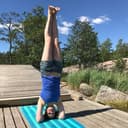
8 Best Stretching Apps of 2025 for All Fitness Levels
Table of Contents
- The Best Stretching Apps Reviewed
- Ready to Roll Out Your Mat?
- 2. Best for Progress Tracking — StretchIt
- 3. Best for Athletes — Pliability
- 4. Best Free Stretching App — Bend
- 5. Best for Back and Neck Pain — Back Doctor by Dr. Robert Watkins
- 6. Best for Beginners — Start Stretching
- 7. Best Seated Stretching for Seniors — Chair Yoga for Seniors: SitFit
- 8. Best for Doing Splits — Split Workout: Split in 30 Days
- How to Choose a Stretching App
- How to Build a Consistent Stretching Habit
- Conclusion
- FAQs
Feeling stiff after long hours at your desk? Struggling to bounce back after workouts? Or maybe you’ve tried stretching routines before but got bored, fed up, or unsure if they were actually helping. The right stretching app can change all that, helping you move better, recover faster, and build a routine that actually sticks.
A common mistake is thinking there’s a one-size-fits-all stretching app. The best app for you depends on your goals. Whether you want to improve flexibility, recover faster, reduce pain, or build a consistent daily wellness habit, one app might work wonders for you while another falls flat.
That’s why I’ve done the heavy lifting for you. In this guide, you’ll find eight different stretching apps, each handpicked to suit different goals, lifestyles, and experience levels.
Whether you’re an athlete looking to enhance performance, a beginner easing into movement, or just someone who wants to feel a little looser after long hours at a desk, you’ll find an app here that helps you stay consistent with an effective stretching routine.
The Best Stretching Apps Reviewed
1. Best for Stretching and Mindful Movement — Yogaia
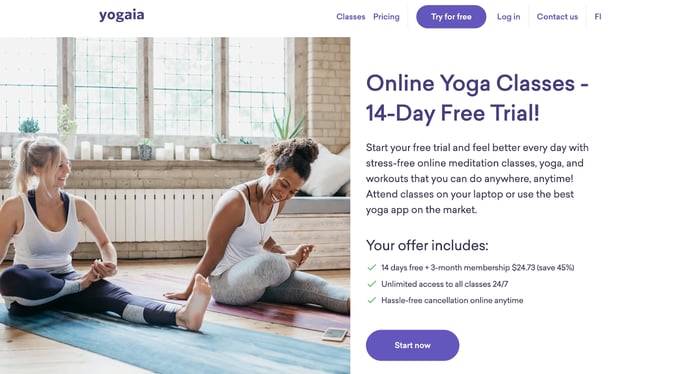
If you’re looking for stretching, plus a full-body and mind wellness experience, Yogaia is a perfect fit for you. While most stretching apps focus on static stretching, Yogaia takes things a step further with dynamic stretching—gentle flowing movements that release tight muscles and improve mobility and circulation.
Who Yogaia Is For
Beginners easing into movement
Active people looking to stay consistent
Seniors who seek gentle mobility
Anyone recovering from injury or looking for guided, mindful stretching
What Makes Yogaia Stand Out
You can join real-time sessions led by experienced instructors who guide you through each movement—and if you like, you can turn your camera on for personalized feedback. It’s especially helpful if you’re new to stretching or undergoing physical therapy and need extra guidance with your form.
Beyond the live classes, Yogaia also gives you access to a large on-demand library, from short mobility flows that loosen you up in minutes to full-length yoga sessions that deepen your flexibility and calm your mind. You'll also find targeted stretching and mobility classes for Hips, Neck & Shoulders, and Back that help you ease tension in those areas.
Classes are organized by goal, intensity, and experience level, so it’s easy to find one that matches your mood, whether you’re after a gentle morning stretch or a soothing flow before bed. And with Yogaia’s warm, global community practicing right alongside you, you’ll always have the motivation and support to keep showing up one stretch at a time.
Key Features:
Live and on-demand classes
Certified instructors
Stretching, yoga, meditation & mindfulness
Beginner and senior-friendly routines
Rating: 4.8/5 on App Store
Pros:
Free stretching classes available on the webite
Live instructor-led classes
Holistic wellness approach
Customizable programs by goal or fitness level
Available on iOS, Android, and web
Cons:
Requires a paid subscription after the free trial
Pricing:
14-day free trial
Special offer: $8.24/month for the first 3 months (best value!).
Regular subscriptions: $19.99/month or $119.88/year
Ready to Roll Out Your Mat?
Start your own online yoga journey today with Yogaia. No pressure, no commute—just calm, connection, and convenience.
2. Best for Progress Tracking — StretchIt
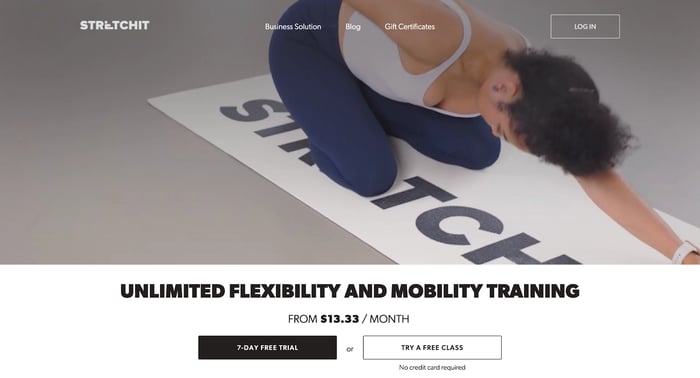
If your main goal is to improve flexibility and track your progress, StretchIt is a great choice. The app offers structured 30-day programs led by expert instructors, guiding you through targeted routines for skills like splits, backbends, hamstring mobility, and more. Classes are delivered through easy-to-follow video demonstrations, making it simple to focus on form and gradual improvement.
One standout feature is the app's progress tracking. StretchIt helps you actually see your progress through pictures. On the app, you can snap a quick photo of your stretch, compare it with previous progress shots, and see the flexibility you’ve gained. Seeing your progress keeps you motivated to build a regular stretching habit.
Though StretchIt is tailored specifically for improving flexibility, it caters to all skill levels, with gentle beginner routines as well as intermediate and advanced deep-stretch classes.
Key Features:
30-day flexibility-focused programs
Progress tracking with pose photos and achievement milestones
Video-led classes with step-by-step guidance
Routines targeting splits, backbends, and full-body mobility
Available on iOS and Android
Rating: 4.8/5 on App Store
Pros:
Visual progress tracking keeps you motivated
Structured programs for accountability
Options for every level, from beginner to advanced
Cons:
No live classes or interactive instructor support
Pricing:
7-day free trial
Free classes: A limited selection of additional classes is available.
Subscription: $19.99/month or $159.99/year
3. Best for Athletes — Pliability
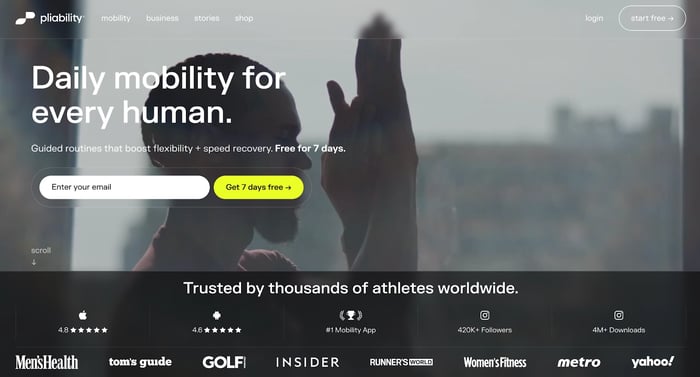
Previously known as ROMWOD, the Pliability app is designed with athletes and active people in mind. Sessions are short and equipment-free, usually under 20 minutes, so they easily fit before a workout or as a post-run cooldown. The routines target major muscle groups like your hips, hamstrings, shoulders, and spine—the areas that work hardest when you’re pushing limits.
One thing athletes love about Pliability is how it integrates with wearables like WHOOP and Garmin. You can sync your mobility sessions alongside your recovery data, which is a big plus if you like to monitor your fitness data. If you’re serious about recovery and performance, Pliability deserves a spot in your routine.
Key Features:
Daily guided mobility and stretching routines
Focused on athletic recovery, injury prevention, and flexibility
Integration with wearables (WHOOP, Garmin, and more)
No equipment required
Led by knowledgeable performance coaches
Rating: 4.8/5 on App Store
Pros:
Designed to support high athletic performance and recovery
Daily sessions help athletes stay consistent
Totally equipment-free—easy to use at home or on the go
Cons:
Not ideal for beginners or seniors
Lacks live classes
Pricing
7-day free trial
Subscription: $17.95/month or $179.95/year
4. Best Free Stretching App — Bend
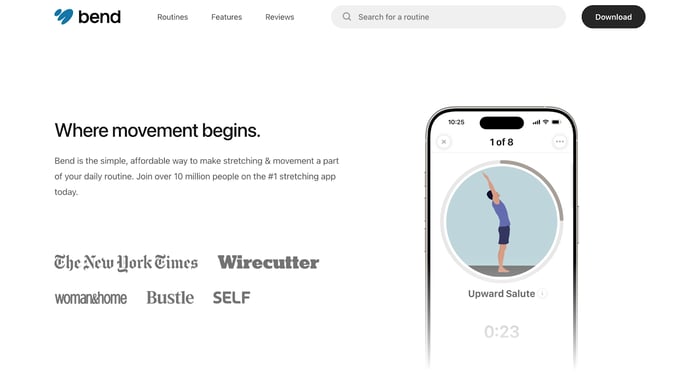
If you’re looking for a way to stretch consistently without overcomplicating things, Bend is a solid choice. The app is built to fit into your daily routine, whether you have five minutes between meetings, a quick cooldown after a workout, or want a moment to release tension before bed.
Its routines cover major areas that often feel tight, such as the hips, hamstrings, back, and shoulders, in order to loosen your body and improve your range of motion.
What makes Bend stand out is how it adjusts to you. You can follow ready-made sessions or create your own routine based on what you need that day. The app even offers suggestions based on your goals and experience, so you don’t waste time on stretches that won’t make a difference.
Plus, features like streak tracking and reminders make it easier to turn stretching into a consistent habit.
Key Features:
Hundreds of physical therapy-inspired stretching routines, including those for neck, back, hips, and hamstrings.
Personalized program creation and AI-powered suggestions
Progress tracking and reminders
Ad-free with a minimalist interface
Available on both App Store and Google Play
Rating: 4.8/5 on App Store
Pros:
Huge variety of routines for all body areas and flexibility levels
Customizable, clear instructions with educational benefits
Popular free tier makes it accessible for everyone
Cons:
Some users find the free version a bit limited in advanced content
Premium routines and advanced progress tracking require a paid upgrade
Pricing:
Free to download
Premium: $13.99/month or $39.99/year (yearly discounts may apply)
5. Best for Back and Neck Pain — Back Doctor by Dr. Robert Watkins

If you struggle with back or neck pain, Back Doctor was designed with you in mind. The app, created by spine surgeons, brings the same expert approach they use with their patients straight to your phone, so you can stretch safely at home.
Once you sign in, you’ll find targeted routines for common neck and lower back issues—from herniated discs and sciatica to posture problems and sports injuries. HD video tutorials guide you through every move, showing proper form, timing, and reps, so you can follow along confidently, even if it's your first time using a rehab app.
The app also tracks your progress and offers a smart scoring system, helping you see improvements in strength and know when you’re ready to return to activity safely.. The best part? The app is completely free and ad-free, so you can focus on feeling better without distractions.
Key Features:
100% free and ad-free
Developed by spine specialists and used by professional athletes
HD video guidance for proper form, timing, and reps
Tailored routines for spine recovery, core strengthening, and pain relief
On-screen corrections to guide your movements
Suitable for solo use or as a complement to physical therapy
Rating: 4.8/5 on App Store
Pros:
Expert-designed, science-backed exercises for neck and back health
Free, with full access to all routines
Targeted sessions for acute pain, rehab, and injury prevention
Progress tracking and readiness scoring
Cons:
Focused on spine and neck issues; less variety for general stretching
No live coaching
Pricing
Free
Dealing with lower back pain? These yoga poses can target the pain points and help you feel relieved.
6. Best for Beginners — Start Stretching

If you’ve been meaning to stretch more but don’t know how to go about it, Start Stretching is a good starting point. From the moment you open the app, you’re greeted with simple, approachable routines—no full splits or intimidating moves.
One of the most useful features is the built-in timer. You set how long to hold each stretch and rest between moves, and the app guides you through the session automatically. That means you can squeeze in a quick stretch during a coffee break or take a longer, more relaxing session when you have time.
The app also integrates with Apple Health, so you can track your progress alongside your daily fitness goals. And with streaks and progress stats, you’ll actually see how far you’ve come—making it easier to stay motivated and consistent with your stretching habit.
Key Features:
Simple, beginner-friendly stretches with illustrations and instructions
Adjustable hold times and rest periods
Automatic session cycling for smooth routines
Apple Health integration for tracking progress
Streaks and stats to build consistency
No equipment required
Rating: 4.6/5 on App Store
Pros:
Approachable routines for complete beginners
Clear guidance removes all guesswork
Flexible sessions for any schedule
Habit-tracking tools help you stay consistent
Cons:
The free version has a limited library
No videos or audio guidance—just illustrations and text
Not for advanced stretching or flexibility challenges
Ads are present in the free version
Pricing:
Free basic version
Premium: $1.99 one-time purchase
7. Best Seated Stretching for Seniors — Chair Yoga for Seniors: SitFit

If you’re a senior or anyone with limited mobility, joint pain, or balance concerns, SitFit helps you stretch without discomfort. Unlike typical stretching apps, SitFit is designed specifically for seated exercises, so you don’t need to worry about standing for long periods or getting up and down from the floor.
The app offers gentle, low-impact routines that target common concerns like hip mobility, tight shoulders, and sore backs. Each session is guided by certified instructors, so you can follow along safely and confidently. Over time, these stretches can help ease everyday aches, improve your range of motion, and support strength and balance without leaving your chair.
Key Features:
Personalized chair yoga plans for seniors and those with limited mobility
Low-impact, gentle movements that target flexibility, strength, and circulation
Step-by-step video guidance from certified yoga instructors
Focus on easing stiffness and improving mobility
No standing or floor exercises required
Free to start with multiple routines available
Rating: 4.6/5 on App Store
Pros:
Perfect if mobility, balance, or joint pain makes standing difficult
Safe, slow-paced routines with professional guidance
Adjustable pace and clear voice instructions
Helps maintain flexibility, strength, and independence
Cons:
Might feel too gentle for more active seniors
Limited advanced routines or additional features
Pricing:
Free version available
Premium: $6.99/month, $22.99/year
Lifetime premium plan: $79.99 one-time
Want more gentle chair stretches that improve your flexibility? You would love these chair yoga poses.
8. Best for Doing Splits — Split Workout: Split in 30 Days

If one of your goals is to finally master the splits, or just feel looser through your hips and legs, Split Workout makes the process simple for you.
The app guides you through a 30-day flexibility program that gradually opens up your hip flexors, hamstrings, quads, and lower back. Each session starts with a short warm-up, then moves into targeted stretches designed to help your body ease deeper over time without forcing your joints.
With 10 minutes a day and some floor space, you can gradually build hip flexibility using this app. It also lets you choose whether to focus on your left or right split (or both) and track how far you’ve come as the days go by. The video demonstrations for each program are clear and encouraging, making it easy to follow along safely, even if you’re new to stretching.
Key Features:
30-day split training routine
Stretches for the hip, hamstring, quadriceps, and lower back flexibility
Video instructions and customizable levels for beginner, intermediate, and advanced
Progress tracking and motivational reminders
No equipment needed, just bodyweight exercises
Calorie tracker included
Rating: 4.9/5 on App Store
Pros:
Well-structured routines that gradually improve flexibility
Great for beginners but still challenging for experienced users
Most features are available for free
Daily reminders make it easier to stay accountable
Cons:
The free version includes ads, which can interrupt your focus
Pricing:
Free version available.
Premium plans:
$3.49/week
$6.99/month
$29.99/year
Lifetime membership: $34.99 one-time
How to Choose a Stretching App
Choosing a stretching app isn’t as easy as finding the one with the most downloads. Rather, the app you choose should support your experience level, align with your goals, and make it easier to build a consistent stretching habit. Here’s what to consider before you hit “download.”
1. Personalized onboarding
Look for apps that ask a few simple questions before you start — about your age, fitness level, and so on. These help the app tailor your routines so you begin safely and at a pace that feels right for your body.
2. Progress that feels natural
Stretching takes time, and progress looks different for everyone. Look for an app with programs that progress gradually from short beginner routines to more advanced sequences, so you can build flexibility at your own pace without strain or pressure.
3. Built-in safety cues
The best stretching apps guide you gently through each move, reminding you to breathe, avoid pain, and move within your range. Clear cues, warm-ups, and modification options go a long way in helping you stretch safely and confidently.
4. Accessibility
If you need larger text, captions, or voice guidance, choose apps that make provisions for these features, so that you can follow the routines comfortably. And if standing or floor stretches are tricky, go for apps that include seated or chair-based stretching options.
5. Support for consistency
We all need a little reminder sometimes. Apps that send gentle reminders, track your streaks, or sync with Apple Health or Google Fit can keep stretching at the top of your mind, helping you build a habit.
6. Privacy & ads
Check how the app handles your data, especially in free versions. Look for options to control notifications and ensure ads aren’t intrusive. If ads interrupt your flow, it might be worth upgrading to a premium plan for a smoother experience.
How to Build a Consistent Stretching Habit
Start Small
Even 5–10 minutes two times a week makes a difference. Pick a short routine you can realistically commit to, whether it’s morning mobility, a midday desk stretch, or an evening cooldown.
Set a Cue
Tie stretching to something you already do daily—after brushing your teeth, before your morning coffee, or right after a workout. This makes it automatic instead of a decision you have to force.
Use Reminders & Streaks
Apps like Yogaia, Bend, or Start Stretching can gently nudge you with notifications, track streaks, and log progress. Seeing small wins accumulate is surprisingly motivating.
Mix It Up
Avoid boredom by rotating routines. Alternate full-body flows, targeted stretches, or chair yoga. Variety keeps you engaged and addresses different areas of your body.
Conclusion
Different stretching apps are designed to meet different goals, whether that's improving flexibility, easing pain, or simply building a daily routine that fits your life. Depending on your starting point or needs, choosing any of the apps reviewed in this guide can help make stretching safe, enjoyable, and effective.
If you're looking to combine stretching with yoga, meditation, live coaching, and real accountability, Yogaia pulls it all together. With live classes, real-time instructor feedback, thousands of on-demand routines, and programs for every level, it’s a full wellness experience that supports both your body and mind.
Ready to feel more flexible, energized, and balanced every day? Start your 14-day free trial with Yogaia, join a live class, and discover routines that relieve tension, improve your posture, and leave you feeling refreshed.
For more tips on staying consistent with short, effective routines, see our post on why small daily habits win.
FAQs
Is stretching 20 minutes a day worth it?
Absolutely! Just 20 minutes of stretching a day can help loosen tight muscles, improve posture, boost mobility, and aid muscle recovery. The key is consistency. Over time, even short daily sessions add up, making your body feel more comfortable, flexible, and energized.
Are free stretching apps worth it?
Free apps are great for starting out. They usually cover basic routines, reminders, and habit tracking, which is perfect for casual daily stretching. However, paid apps go a step further, offering personalized programs, video guidance, advanced tracking, expert feedback, and other additional features. If you want more variety, structured plans, or an ad-free experience, investing in a paid app can be worth it.
What’s the best time of day to stretch?
There’s no perfect time. Morning stretching can wake up your muscles and prepare you for the day, while evening or post-workout sessions help release tension and aid recovery. The best time is the one you can stick to consistently.
How often should you stretch?
Stretching about three times a week is enough to improve flexibility and ease stiffness. You can also add a daily mobility routine, like rolling your shoulders and moving your spine. For healthy, flexible joints, combine mobility work with a few dedicated stretching sessions per week.
